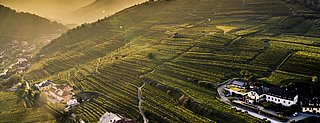
Setzberg
Facts:
- Town:
- Spitz
- Subsites:
- Vogelsang , Landstallen
- Size in ha:
- 41,39
- Altitude in m:
- 216 - 392
- Aspect:
- W - SE
- Average Slope in %:
- 32
- Max. Slope in %:
- 77
- Insolation in hours per year:
- 2101
- Terraced vineyard:
- Yes
- Distance to Danube in m:
- 441
- Labour required in h:
- 31.000
- First documentary evidence:
- 1243
Winery
-

Weingärtnerei Helmut Donabaum
Spitz -

Weingut Strawanzer Donabaum
Spitz -

Weingut Johann Donabaum
Spitz -

Weingut Gebetsberger
Spitz -

Graben Gritsch
Spitz -

Weingut Roman Gritsch
Spitz -

Weingut Thomas Gritsch
Spitz -

Weingut Franz Hirtzberger
Spitz -

Weingut Lagler
Spitz -

Weingut Mayer
Spitz -

Weingut Nothnagl
Spitz -

Weingut Florian Schneeweis
Spitz -

Weingut Schöberl
Spitz
Description
"The Setzberg must be divided into a large eastern half and a smaller western half. The probably most valuable dry grassland of the Wachau region lies between the two halves, which is also a designated natural monument.
In geological terms, the mountain unites several types of metamorphic rock: paragneiss, Spitzer granodiorite gneiss, marble, silicate marble, calc-silicate gneiss and scattered patches of loess on the east slope. In terms of the surface area, the variable paragneiss plays the most important role. It is therefore no surprise that the paragneisses occur in different forms on the Spitz and Laaben sides.
The location also represents a climatic divide separating the vineyards of Spitz from those of the Spitzer Graben. The wines produced on the two sides of the mountain differ accordingly."
Soil Profile Eastern Setzberg
The profile was taken from the highest vineyard on the Spitz side. The fine, sandy and stony soil, with humus accumulation in the upper 15 cm, lies directly above the compact parent rock consisting of paragneiss dominated by amphibolite. Fissures and joints are coated with carbonate precipitates, a weathering relict from the former loess cover.

